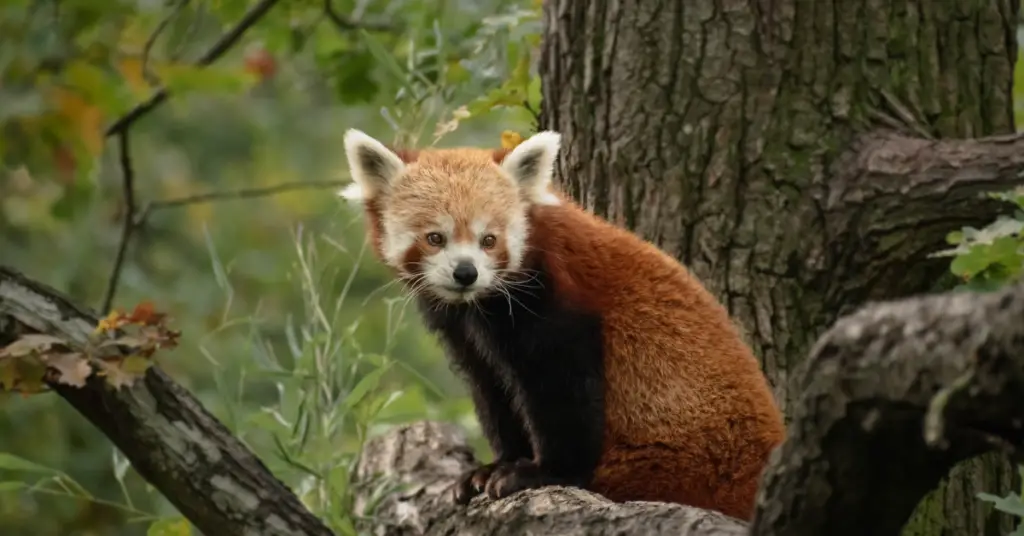This blog contains affiliate links. As part of afiiliate networks and as an Amazon Associate, I earn from qualifying purchases. If you make a purchase through these links, I may earn a small commission at no additional cost to you. I only recommend products and services that I believe in and have personally used or researched. Your support helps me continue to provide quality content—thank you!
Red Panda Habitat
Red pandas are adorable creatures known for their distinctive reddish-brown fur and bushy tails. But while they may look like raccoons or foxes, they are actually more closely related to skunks and weasels. Found primarily in the Himalayan region of Asia, these fascinating animals have adapted to a specific type of environment that is essential for their survival.
The Range of the Red Panda
Red pandas are native to the eastern Himalayas and southwestern China. Their range includes parts of Nepal, Bhutan, Myanmar, and northern India. Within this region, they are found in a variety of forest habitats, ranging from temperate deciduous forests to sub-alpine coniferous forests.
Forest Habitat
Red pandas are arboreal, meaning they spend most of their time in trees. They are well adapted to life in the forest, with strong claws and a flexible ankle joint that allows them to climb and move easily through trees. They are most commonly found in dense forests with plenty of bamboo, their primary food source.
Red pandas are adapted to life in forests, where they can find the trees they need to climb and hide in. They are well-suited to living in dense forests with plenty of cover and shade. Their fur helps them blend into their surroundings, making it easier for them to hide from predators and hunt for food
Bamboo Forests
Bamboo is a crucial element of the red panda’s habitat. They are highly dependent on bamboo for their diet, with around 95% of their food consisting of bamboo leaves and shoots. They are able to digest bamboo thanks to a special bacteria in their gut that breaks down the tough fibers of the plant.
Bamboo forests are particularly important to the red panda’s survival. They rely on bamboo for most of their diet, and they can consume a lot of it each day. Bamboo forests provide the red panda with a steady supply of food throughout the year. In addition, the bamboo provides shelter and shade for the red panda and other animals.
Forest Types
Red pandas can be found in a variety of forest types within their range. In Nepal, they are found in temperate broadleaf and mixed forests, as well as subtropical broadleaf forests. In China, they are found in sub-alpine coniferous forests, as well as temperate deciduous and mixed forests.
Forest Structure
The red panda is adapted to living in forests with a dense understory and a canopy that allows some light to filter through. This type of forest structure provides them with the cover and shelter they need to avoid predators and feel secure. In addition, the forest floor provides them with the vegetation they need to forage for food.
Other Vegetation
While bamboo is the mainstay of the red panda’s diet, they also eat other vegetation, including fruit, berries, and acorns. They have even been known to eat small birds and rodents on occasion.
Altitude
Red pandas are found at a range of altitudes, from 1,500 to 4,000 meters above sea level.
They are particularly well-adapted to cooler mountainous regions, where they can find the bamboo and other vegetation they need to survive. Their thick fur helps them stay warm in colder temperatures, and their ability to climb trees allows them to escape predators and seek out food.
Red panda distribution
Red pandas are native to the eastern Himalayas and southwestern China. Their range includes parts of Nepal, Bhutan, Myanmar, and northern India. Within this region, they are found in a variety of forest habitats, ranging from temperate deciduous forests to sub-alpine coniferous forests.Their range has historically been more extensive, covering a larger part of Asia, including parts of northern Myanmar, northeastern India, and eastern Tibet.
However, their range has been reduced due to habitat loss and fragmentation caused by human activities. The exact number of red pandas in the wild is unknown, but it is believed that there are fewer than 10,000 individuals remaining. The population is fragmented and isolated, with some subpopulations numbering only a few dozen individuals.
Red pandas are primarily found in a few countries in Asia, including Nepal, Bhutan, India, Myanmar, and China. Within these countries, they are found in a variety of forest habitats, ranging from temperate deciduous forests to sub-alpine coniferous forests.
In Nepal, red pandas can be seen n the Langtang National Park, the Makalu Barun National Park, and the Sagarmatha National Park, among other protected areas. They are also found in community forests and other non-protected areas in the eastern and central regions of the country.
In Nepal, red pandas are found in the central and eastern parts of the country, with their distribution range extending from the Taplejung district in the east to the Darchula district in the west. According to the Red Panda Network, there are approximately 300-400 red pandas in Nepal, with the majority of the population living in the eastern part of the country. Red pandas are considered a national treasure in Nepal and are protected under the National Parks and Wildlife Conservation Act.
In Bhutan, red pandas can be seen in the Wangchuck Centennial National Park, the Jigme Dorji National Park, and the Jomotsangkha Wildlife Sanctuary, among other protected areas. They are also found in community forests and other non-protected areas in the eastern and central regions of the country.
In Bhutan, red pandas are found in the eastern and central parts of the country, with their distribution range extending from the Samdrup Jongkhar district in the east to the Haa district in the west. According to the Bhutan Foundation, there are approximately 100-200 red pandas in Bhutan, with the majority of the population living in the eastern part of the country. Red pandas are considered a national treasure in Bhutan and are protected under the Forest and Nature Conservation Act.
In India, red pandas can be seen in the Singalila National Park and the Khangchendzonga National Park, both of which are located in the state of Sikkim. They are also found in Arunachal Pradesh and parts of northeastern India.
In India, red pandas are found in the northern part of the country, with their distribution range extending from the Sikkim state in the east to the Arunachal Pradesh state in the west. According to the International Union for Conservation of Nature (IUCN), there are approximately 1,000-2,500 red pandas in India. Red pandas are listed as endangered under the Indian Wildlife Protection Act.
In Myanmar, red pandas can be seen in the Hkakaborazi National Park, which is located in the northern part of the country. They are also found in other protected areas and non-protected forests in the region.
In Myanmar, red pandas are found in the northern part of the country, with their distribution range extending from the Kachin state in the east to the Chin state in the west. According to the IUCN, there are approximately 300-1,000 red pandas in Myanmar. Red pandas are protected under the Wildlife Protection Act.
In China, red pandas are found in the provinces of Sichuan, Yunnan, and Tibet, as well as in the autonomous region of Xizang (Tibet). They are found in a variety of protected areas, including the Wolong Nature Reserve, the Jiuzhaigou Nature Reserve, and the Yading Nature Reserve, among others.
According to the IUCN, there are approximately 3,000-7,000 red pandas in China. Red pandas are listed as a first-class protected species under the Chinese Wildlife Protection Act.
Conservation efforts are focused on protecting the remaining habitat of red pandas and connecting fragmented populations through corridors and habitat restoration. Efforts are also being made to reduce poaching and hunting of red pandas, which remains a significant threat to their survival. Overall, the distribution of red pandas is limited, and their survival depends on the protection of their habitat and the reduction of human impacts on their populations.
Fragmentation
The habitat of the red panda is becoming increasingly fragmented due to human activities such as deforestation, agriculture, and infrastructure development. Fragmentation can lead to isolated populations of red pandas, which can reduce genetic diversity and increase the risk of inbreeding. Efforts to protect and restore the habitat of red pandas, as well as to connect fragmented populations, are critical to their survival.
Red pandas are classified as endangered by the IUCN, and their population is declining. Conservation efforts are focused on protecting their habitat and reducing the impact of human activities on their populations. These efforts include the creation of protected areas, habitat restoration, and community-based conservation programs. In addition, research is being conducted to better understand the behavior and ecology of red pandas, which can inform conservation strategies.
The natural habitat of a red panda consists of forested areas with plenty of bamboo, ranging from temperate deciduous forests to sub-alpine coniferous forests. They are arboreal, spending most of their time in trees, and are well adapted to life in the cooler mountainous regions. While they face many threats to their survival, there are also many organizations working to protect them and their habitat.
PLACES WHERE YOU CAN SEE RED PANDAS
| Country | National Park/Sanctuary/Region |
|---|---|
| Bhutan | Jigme Singye Wangchuck National Park, Royal Manas National Park, Phibsoo Wildlife Sanctuary |
| China | Wolong National Nature Reserve, Fengtongzhai National Nature Reserve, Yele Nature Reserve |
| India | Arunachal Pradesh: Namdapha National Park, Pakke Tiger Reserve, Eaglenest Wildlife Sanctuary Sikkim: Kanchenjunga National Park, Barsey Rhododendron Sanctuary, Fambong Lho Wildlife Sanctuary West Bengal: Neora Valley National Park, Singalila National Park, Mahananda Wildlife Sanctuary |
| Myanmar | Hkakabo Razi National Park, Namha National Park |
| Nepal | Langtang National Park, Langtang Valley, Sagarmatha Zone |
| Pakistan | Deosai National Park |
| Taiwan | Taroko National Park (introduced population) |
Note:
- This table only includes countries, national parks, sanctuaries, and regions where red pandas are known to exist in the wild or have been reintroduced.
- The list may not be exhaustive, as new conservation efforts and research may have led to the discovery of additional habitats.
- In some cases, the red panda’s presence may be limited to specific areas within a national park or sanctuary.
Please keep in mind that red pandas are endangered, and their habitats are often fragmented and limited. It’s essential to respect their natural habitats and support conservation efforts to protect these amazing creatures.

Erzsebet Frey (Eli Frey) is an ecologist and online entrepreneur with a Master of Science in Ecology from the University of Belgrade. Originally from Serbia, she has lived in Sri Lanka since 2017. Eli has worked internationally in countries like Oman, Brazil, Germany, and Sri Lanka. In 2018, she expanded into SEO and blogging, completing courses from UC Davis and Edinburgh. Eli has founded multiple websites focused on biology, ecology, environmental science, sustainable and simple living, and outdoor activities. She enjoys creating nature and simple living videos on YouTube and participates in speleology, diving, and hiking.

